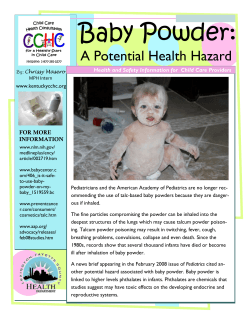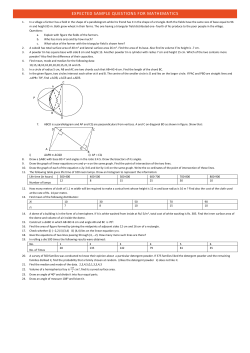
Full Paper
ISSN 2394-3777 (Print) ISSN 2394-3785 (Online) Available online at www.ijartet.com International Journal of Advanced Research Trends in Engineering and Technology (IJARTET) Vol. 2, Issue 3, March 2015 A Survey of Aluminium Metal Matrix Composites Using Powder Metallurgy Technique M.Meignanamoorthy1, S.Sakthivelu2, M.Ravichandran3 PG Scholar, Department of manufacturing engineering, Chendhuran College of Engineering and Technology, Pudukkottai – 622507, Tamilnadu, India. 2 PG Scholar, Department of manufacturing engineering, Chendhuran College of Engineering and Technology, Pudukkottai – 622507, Tamilnadu, India. 3 Associate Prof, Department of mechanical engineering, ChendhuranCollege of Engineering and Technology,Pudukkottai – 622507, Tamilnadu, India. 1 Abstract: - Aluminium metal matrix composites have gained importance in various industries because of their good mechanical properties. Aluminium metal matrix composites are preferred in the fields of aerospace, military, automotive, marine and in other domestic applications. The different reinforcements with aluminium metal matrix composites by powder metallurgy technique results in improved mechanical properties such as ultimate tensile strength, compressive strength, hardness, wear rate. Powder metallurgy is an ideal method of fabrication for MMCs because of the ability to produce near net shapes and little material waste associated with this process. In this survey an attempt has been made to consolidate some of the aspects of mechanical properties of Aluminium MMCs fabricated using Powder Metallurgy Technique. Keywords: Metal matrix composites, Aluminium metal matrix composites, Powder metallurgy, Mechanical Properties powder particles can be analyzed by X-ray diffraction I. INTRODUCTION analysis (XRD) and Energy dispersive X-ray analysis Aluminium based composite materials are leading (EDAX). ones in this area, they are fabricated using many methods, II. LITERATURE REVIEW including powder metallurgy processes. Powder metallurgy is the process of making components with required properties and shape by mixing metal and non-metal Vanitha et al [1]. Studied the mechanical properties powders. Powder metal products are manufactured by the of aluminium and aluminium based titania composites by various procedures such as manufacturing of metal powders, powder metallurgy technique with different particulates blending, compacting, sintering, finishing and sizing. Light weight percentage (6 and 12%). The density of the metal matrix composite materials with ceramic particles as composite is increased whenever weight percent was reinforcements have received widespread studies during the increased. The tensile strength of the composite was past decades because of their superior mechanical properties. increased with increase in the weight percentage of the Based, on the detailed literature survey the reinforcements titania composites. such alumina, titania, zirconia when mixed with AMMCs Ravichandran et al [2]. Synthesized and studied the fabricated by using powder metallurgy have good forming behavior of aluminium-based hybrid powder mechanical properties. The material distribution can be metallurgic composites. Aluminium-based metal matrix analyzed by using SEM & TEM technique. Finally the composites were synthesized from Al-TiO2-Gr powder mechanical properties can be analyzed by Universal testing mixtures using the powder metallurgy technique and their machine and hardness tester. The characterization of the forming characteristics were studied during cold upsetting. ISSN 2394-3777 (Print) ISSN 2394-3785 (Online) Available online at www.ijartet.com International Journal of Advanced Research Trends in Engineering and Technology (IJARTET) Vol. II, Issue I, January 2015 The addition of both TiO2 and Gr reduces the densification and deformation characteristics of the sintered preforms during cold upsetting. Wiodarczyk-Fligier et al [3]. Fabricate the aluminium metal matrix composite material reinforced with Al2O3 particles. This manufacturing method shows the manufacturing of aluminium metal matrix composites with any reinforcement can be easily fabricated by powder metallurgy technique with required structure joining positive properties composite materials components. Asif et al [4]. Development of aluminium based hybrid metal matrix composites for heavy duty applications. This paper shows the investigations on dry sliding wear behavior of aluminium based composites, reinforced with silicon carbide particles and solid lubricants such as graphite/antimony tri sulphide (Sb2S3). Both composites were mixed and fabricated by powder metallurgy technique. Final results shows that the proposed composites have lower friction coefficient, less temperature rise and low noise level; however they have little higher wear rate. Mahboob et al [5]. Investigates the influence of nanosized Al2O3 weight percentage on microstructure and mechanical properties of Al–matrix nanocomposite by powder metallurgy technique. In their research, the morphological, micro structural and mechanical properties changes during nanosized alumina increment to Al powder were studied. The process was carried out for different weight percentage Al–(0–20) wt-%Al2O3. Their results showed that the strength, ductility and hardness were increased by increasing the reinforcement nano particles weight percentage. Gokce et al [7]. Investigations on mechanical and physical properties of sintered aluminum powders through powder metallurgy route. In this study green and theoretical density increased with the increment of compaction pressure. The mechanical performance is very good for both pressures during the transverse rupture (three point bending test) owing to enhanced diffusion in the mentioned sintering process. Sujit Das et al [8]. Experimental Analysis of Density of Sintered SiCp Reinforced AMMCS Using the Response Surface Method. The paper aim is to fabricate AlSiCp composites by powder metallurgy (P/M) processing route. An experimental investigation have been undertaken in order to understand the variation of density with respect to the variation of process parameters viz., variation of silicon carbide proportion, compacting pressure and sintering time. The relation among the various process parameters with density has been studied. A mathematical model has been developed using second order response surface model (RSM) with central composite design (CCD) considering the above mentioned process parameters. The model shows increase in density due to change in wt% of SiCp (x1) and sintering time for compaction load from 40-93.63586 Ton at a fixed sintering time of 40 minutes and for a fixed value of compacting pressure (x2). The response variable, density (R1) shows linear increase when it is plotted against sintering time (x3) and compacting pressure (x2) for a fixed value of wt% of SiCp (x1) and the prediction of density variation from the mathematical model developed in this study matches closely with the observed data (R2 = 89.8 %). The microstructure shows the uniform distribution of Shanta et al [6]. Investigates the processing, particles. microstructure and properties of hybrid metallic and ceramic reinforced aluminium composites via P/M technique. In this Dinesh Kumar Koli et al [9]. Properties and work the combined Ti (micro) and Al2O3 (micro or nano) Characterization of Al-Al2O3 Composites Processed particles reinforced commercially with pure Al matrix Powder Metallurgy Routes. This paper shows the composites have been developed via powder metallurgy characterization of mechanical properties with production route.A detailed microstructural characterization and the evaluation of mechanical properties including wear and routes of powder metallurgy for aluminium matrixcorrosion behaviour have been carried out.The composites Al2O3composites.A uniform distribution of the reinforced with the ceramic particles (micro or nano) alone Al2O3reinforcement phase in the Al matrix can be exhibited higher hardness values. Micro structural obtained by high-energy ball milling of Al– Al2O3blends. characterization revealed that there is a uniform distribution Nearly 92% increase in the hardness and 57% increase in in the composites. The hybrid composites exhibit a better the tensile strength were obtained in the nano-composites wear resistance than the composite reinforced with as compared to the commercially pure aluminium. individuals particles owing to their higher hardness as compared to that of the other composites. All Rights Reserved © 2015 IJARTET 54 ISSN 2394-3777 (Print) ISSN 2394-3785 (Online) Available online at www.ijartet.com International Journal of Advanced Research Trends in Engineering and Technology (IJARTET) Vol. II, Issue I, January 2015 Siddhartha Tiwari et al [10]. Densification Behavior in the Fabrication of Al-Fe Metal Matrix Composite Using Powder Metallurgy Route. This papers deals with the densification behavior of Al-Fe powder particles during compaction and sintering in order to fabricate the Al-Fe metal matrix composites by powder metallurgy route. Green compacts of Al-6.23wt.% Fe powder particles were fabricated under varying compaction pressures, and these fabricated green compacts were sintered over a series of temperatures (430°C–590°C). The sintered products have been characterized with the help of X-ray diffraction (XRD) and scanning electron microscope attached with energy dispersive spectroscopy (EDS). Sintered density increases with increasing sintering temperature up to 550°C whereas a drop in sintered density is perceived at 590°C. This decrease in sintered density is considered to occur due to swelling which has been explained on the basis of the Kirkendall effect. The XRD and EDS analyses of sintered products indicated the presence of Al and Fe particles with the trace amount of intermetallics. The obtained results were briefly explained to understand the mechanisms involved during the densification under compaction and sintering. [3] A.Włodarczyk-Fligier, L.A. Dobrzański, M. Kremzer, M. Adamiak Manufacturing of aluminium matrix composites materials reinforced by Al2O3 particles, Journal of achievements in materials and manufacturing engineering, volume 27, Issue 1, March 2008. [4] Asif M, Chandra K and Misra P S. Development of Aluminium Based Hybrid Metal Matrix Composites for Heavy Duty Applications, Journal of Minerals & Materials Characterization & Engineering, Vol. 10, No. 14 , pp. 13371344, (2011). [5] H. Mahboob, S. A. Sajjadiand S. M. Zebarjad, Influence of nanosized Al2O3 weight percentage on microstructure and mechanical properties of Al–matrix nanocomposite, Powder metallurgy, volume.54, No.2. [6] ShantaMohapatra,Processing, microstructure and properties of hybrid metallic and ceramic reinforced aluminium Composites. [7] A.Gokce, F.Findik, Mechanical and physical properties of sintered aluminum powders, Journal of achievements in materials and manufacturing engineering, volume-30, Issue2, October 2008. III. CONCLUSION From literature review related to the aluminium metal matrix composite material using powder metallurgy technique we concluded that, the pure aluminium mixed with various reinforcements through powder metallurgy fabrication technique it will results in increasing better mechanical properties such as ultimate tensile strength, compressive strength, hardness and reduction in weight. [8] Experimental Analysis of Density of Sintered SiCp Reinforced AMMCS Using the Response Surface Method, Sujit Das, P.K.Bardhan, R.Behera, S. Patra, G. Majumdar, B .Oraon, G. Sutradhar, International journal of research in engineering and technology,volume-3, Issue-8, Aug-2014. [9] Dinesh Kumar Koli, GeetaAgnihotri, Rajesh Purohit, Properties and Characterization of Al-Al2O3 Composites Processed Powder Metallurgy Routes, International journal IV. ACKNOWLEDGEMENT of latest trends in engineering and technology,volume-2, Issue-4, July-2013. The author’s would like to thank the previous [10] Siddhartha Tiwari, Priyanka Rajput, researchers for their contribution in the area of Powder sanjaysrivastavaDensificationBehaviour in the Fabrication of Metallurgy and their valuable references. Al-Fe Metal Matrix Composite Using Powder Metallurgy Route, ISRN Metallurgy, Volume-2012, oct-2012. V. REFERENCES [1]C.Vanitha, K.S.Pandey, Assessment of Mechanical [11] D.Vengatesh, V.Chandramohan, Aluminium Alloy Properties of Sintered and Hot Extruded Aluminium and Metal Matrix composite: Survey Paper, International journal Aluminium Based Titania Composites, American Journal of of engineering research and general science,volume-2, IssueEngineering Research vol-2, Issue-12, pp-194-202 (2013). 6, Nov-2014. [2] M.Ravichandran, A.Naveensait and V.Anandakrishnan, Synthesis and forming behavior of Aluminium-based hybrid [12] B.VijayaRamnath, C.Elanchezhian, RM.Annamalai, T.SriAnandaAtreya, V.Vignesh and powder metallurgic composites, International Journal of S.Aravind, Minerals, Metallurgy and Materials – volume 21, No.2, Feb C.Subramanian, Aluminium Metal Matrix Composites A Review, Advanced material science, (2014). 2014. All Rights Reserved © 2015 IJARTET 55 ISSN 2394-3777 (Print) ISSN 2394-3785 (Online) Available online at www.ijartet.com International Journal of Advanced Research Trends in Engineering and Technology (IJARTET) Vol. II, Issue I, January 2015 [13] Subramanian.R and Angelo.P.C, Powder Metallurgy, Science, Technology and Applications, PHI Publishers (2009). VI. BIOGRAPHY [1]M.Meignanamoorthy is a P.G Scholar in the Department of Manufacturing Engineering, Chendhuran College of Engineering and Technology, Pudukkottai. [2] S.Sakthivelu is a P.G Scholar in the Department of Manufacturing Engineering, Chendhuran College of Engineering and Technology, Pudukkottai. [3] Dr.M.Ravichandran is presently working as associate Professor in the Department Of Mechanical Engineering, Chendhuran College of Engineering and Technology, Pudukkottai. He obtained his Ph.d D degree from Anna University, Chennai. He has published a number of journals in reputed journals and presented in many international conferences and national conferences. His areas of interest in research are Powder metallurgy, welding technology, Optimization techniques. All Rights Reserved © 2015 IJARTET 56
© Copyright 2025









